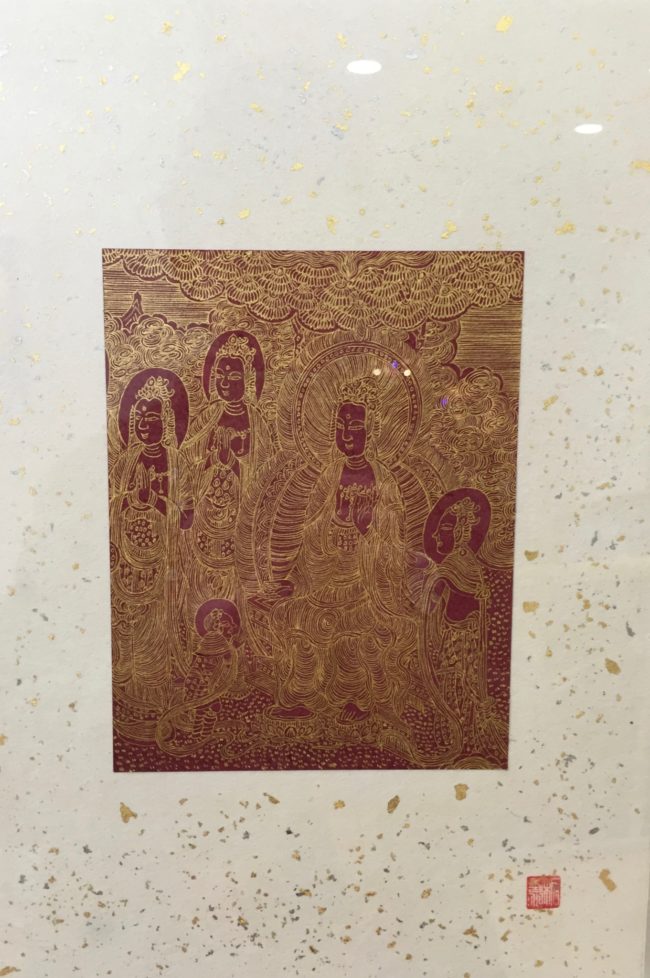Calligraphy and Ink Paintings at the 30th Kyoto Art Festival: International Exhibition of Art 2016

Ink is a medium that is greatly used in Asia but rarely used in Europe, North America, or Oceania. Ink wash, Chinese brush paintings, sumi-e, and ink paintings or calligraphy, shodo, sagyeong or one of the many other names used are highly valued forms of artistic expression in Asia.
Amanda Tseng is a Taiwanese artist who exhibited with this group at the Annex for the first time. Soon after this show, she was in Japan again for another show called Muzinzo at the Tokyo Metropolitan Art Museum with Chang Yih-Ming and Tseng Ting-Yu. The one in Kyoto was delicate, but the ones in Tokyo were powerful. The range was interesting to see. (Her website, www.amandatseng.com, seems to have a few technical problems now, but the images can still be seen in Google images.)
You can see Tseng use her unusual technique around the 30:00 mark. (All in Taiwanese but the visuals can still be understood.)
Nao Mori’s Cosmic Dance K was drawn with ink, not acrylic paint. Should it be called calligraphy, a painting, or a drawing?
Michal Shetrit, who lives and works in Israel, did a subtle calligraphy piece. It was very different from the larger pieces by Japanese artists. This series is similar to other work entitled In the Beginning that also explores words written in Hebrew and in a circle
Park Sun Hwa, a Korean artist, also exhibited in the Annex for the first time. Her small piece was very detailed and an example of sagyeong, Korean traditional illuminated Buddhist sutras.
This is not Park in the video, but the video gives you an idea of the detail and the size. No mistakes can be made.
Ogai Kofude, a Kyoto resident, did a piece that is representative of modern shodo (Japanese brush calligraphy). It can be large, dynamic, and expressive.
Ayumi Deuchi, also a Kyoto resident, did a pair of scrolls that are both modern and traditional. This photo, unfortunately, does not do the paintings justice. The strokes are clear and confident. You can see that Deuchi showed no hesitation when making these marks. I was not sure whether to include this in the nihonga painting section or the ink painting section, because the medium used is almost the same. I think the pigment is more finely ground when used as an ink or water colour, and the binder has to be different for nihonga to better hold the larger particles.
Kyoko Ibe is another Japanese artist whose work could have been placed in several categories. Although she is primarily a paper artist, I decided that the use of sumi (black ink) and the calligraphic marks on the traditional biyobu folding screen might suit the ink painting section. On a traditional biyobu, the hinges are made from handmade paper (washi in Japanese) instead of metal hinges.
This video shows Ibe in action making her pulpy paper. The guide seems to be explaining in German.
Ibe did the paper moon in the background as part of the stage set.
Shunyo Kawarabayashi is a Kyoto resident and one of the organizers of the show. Her calligraphy or shodo is as dynamic and expressive as she is.
As you can see, ink can be used in a multitude of ways ranging from traditional to modern. A calligrapher might make hundreds of pieces repeating the same Chinese characters or kanji but only choose one for exhibition. Even the placement of the signature with a red stamp is important and can affect the balance of the composition.











Leave a Reply